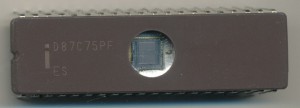EPROM of the Day: Intel D87C75PF The 8755 gets a boost
When Intel released the 8755 in 1976 and 8755A in 1977 it provided an easy way to interface the 8080 and the 8085 to other components. It was a 16k (2kx8) EPROM with a pair of latched 8 bit I/O ports. This greatly reduced system chip counts and complexity of board design. The basic 8755A ran at 3Mhz (the later 8755A-2 ran at 5MHz) which allowed interfacing with the 8085AH with zero wait states. The 8755A continued to be used well into the 1980s with many processors (Intel and others)
By 1988 the 8755A was out of date, its 16k of EPROM space was insufficient for most designs and its power consumption was much higher then contemporary parts. Intel sought to remedy this with the release of the 87C75. The 87C75 is essnetially a 27C256 EPROM, and 82C55A port expander, and latches combined on a single chip. It was made on Intel CHMOSII-E process which reduced power consumption (from 1.5Watts to 500mW). It ran at a max of 5MHz and the EPROM was bumped up from 16k to 256k. It was designed to interface direction to the 8051, MCS-96 and i188 processors.
Why then do we find so few examples of the 87C75PF? The late 80’s and early 90’s also ushered in dozens of microcontrollers and embedded processors that had all of the 87C75’s features on chip; larger EPROM on die, more I/O ports, and the widespread use of Flash on microcontrollers effectively made the 87C75PF obsolete.




June 7th, 2016 at 5:33 am
Wouldn’t be easy to interface the 8755 to an 8080, as you would need to multiplex data and address together, then strobe it into the 8755. The 8755 is designed to be used with the 8085 and 8088 processors as they have multiplexed data/add buses.
June 7th, 2016 at 9:43 am
Definitely correct Thanks!